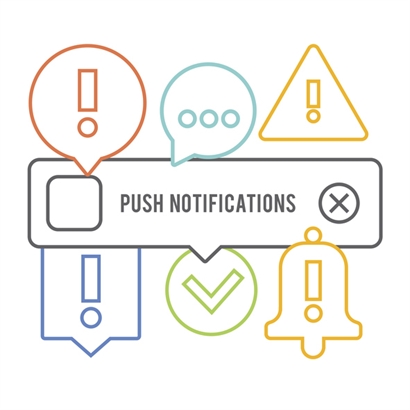3 Reasons to Use Push Notifications
November 06, 2019 by Kendall Ingram

There’s no denying it: apps have taken over the world. From paying bills to finding quick answers to important questions, people spend more time using their mobile phones than desktops or laptops. With that has come increased focus on the mobile app.
Research shows more than 80% of users’ mobile minutes are spent in apps, and that number only continues to rise, growing an average of 6% year over year. Local governments across the country have capitalized on this public interest by launching apps to capture citizens’ attention. With nearly 3 million apps on the market today, how can you ensure your app is delivering value to your community members?
The answer is simple and inexpensive: push notifications.
In the past, the benefits of push notifications have been overlooked in favor of emails, phone calls, text messages, bill inserts, or social media posts. They were often believed to be an invasive form of communication. However, studies have shown mobile users are more willing to receive push notifications than they were just a few short years ago. The caveat: they should be used only to share helpful, relevant information, and they should be used sparingly — no more than two to five per week.
With these guidelines, push notifications can serve as an effective, non-intrusive way to reach your community. Take a look at how your organization can use push notifications to increase community engagement and make an immediate impact.
1. Immediately Disseminate Emergency Information
Whether the crisis is natural or man-made, it’s not a matter of if an emergency is going to occur, but when. Proper preparation ensures efficient communication to maintain residents’ safety and well-being, and helps local governments uphold transparency and accountability.
Mobile apps, like those offered by MyCivic, are essential to any modern emergency communications plan as they’re equipped with push notifications to quickly disseminate emergency news directly to citizens when immediate action is necessary. Notifications also play an important role in relaying emergency information to the hearing impaired, where traditional phone calls and emergency sirens can prove ineffective.
When resident safety is at stake, slowness or failure to communicate emergency information can cause unnecessary danger and stress. Push notifications put up-to-the-minute information at citizens’ fingertips.
2. Target Your Message by Location
It’s something we’re all familiar with: When you download a new app, you’re prompted to answer a couple of key permission questions. Can this app send you notifications? Will you allow this app to access your location?
By answering yes to these questions, users opt-in to targeted push notifications. This enables communities to share important information with residents and visitors in a specific geographic area through their organization’s mobile app. It also ensures the messages you’re delivering are pertinent to your audience, a crucial component of user satisfaction.
Geo-location is an invaluable feature of push notifications that allow communities to send personalized messages and thereby improve citizen experience.
3. Send Real-Time Updates
How much time do your employees spend each day responding to citizen questions? You may not be able to quantify it but, chances are, it’s a lot. Interacting with community members and providing answers is an important part of creating a positive civic experience, but what if there was a more efficient way to go about it?
Take a community power outage, for example. Your office may receive phone calls from many different people to report the outage, and then even more to request updates before the situation is resolved. Instead of addressing these questions one by one, a message can be pushed to all users, to those living in a specified zip code, or based on a geo-located area at once. From there, real-time updates can be provided as community workers respond to and fix the issue.
The ability to send real-time updates is a win-win for local governments and app users. Employees spend less time responding to citizens’ requests for information and more time focused on other tasks, while citizens are informed and engaged.
Push notifications are a winning way to interact with your community’s residents and visitors. By sharing timely, tailored, and valuable information, you will build a deeper connection with your app users and a thriving, connected community.